Archaeologists Discover World’s Oldest Calendar That Could Rewrite Birth of Civilization
Archaeologists have discovered what is believed to be the world’s oldest calendar.
Carved into a 12,000-year-old stone pillar at the mysterious Göbekli Tepe site in Turkey, experts say it could rewrite our timeline of civilization.
The timekeeping system strongly suggests that humans had accurate methods of keeping time as long as 10,000 years before its introduction in ancient Greece in 150 BC.
Another discovery that excites researchers is that the carvings to create an image comet impact which caused a 1,200-year mini ice age that wiped out large animals and spurred the development of agriculture and complex societies.
Researchers discovered the pillar at the archaeological site of Göbekli Tepe in southern Turkey. This pillar appears to be a reminder of a comet impact that heralded the beginning of a Little Ice Age.
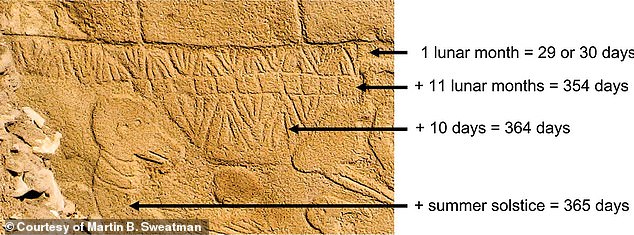
Researchers at the University of Edinburgh counted 365 days of 12 lunar months with 11 extra days, assuming that each ‘V’ marking on the pillar represented one day (see image)
According to experts, this momentous event was the defining moment that forced ancient populations to transition from hunter-gatherer lifestyles to more permanent settlements.
Dr Martin Sweatman from the University of Edinburgh’s Faculty of Engineering, who led the research, said: ‘It seems that the people of Göbekli Tepe were looking very carefully at the sky, which is to be expected given that their world had been devastated by a comet impact.
‘This event may have sparked civilization through the birth of a new religion and developments in agriculture to cope with the cold climate.
‘Their attempts to record what they saw may have been the first steps toward the development of writing millennia later.’
The Gobekli Tepe site is the oldest man-made structure ever found.
It was built between 9,600 and 8,200 BC, over 6,000 years before Stonehenge.
The site contains several stone pillars and after recent analysis, researchers from the University of Edinburgh in Scotland concluded that one of the pillars was shaped like a calendar.
The pillar had a ‘V’ symbol on it, representing one day. The team found 365 engraved on it.
The structure also included 12 lunar months with 11 extra days.
The pillar was divided into two parts with rows of ‘V’ symbols at the top and smaller box symbols in the lower main section. These show a bird holding a circular disc symbol above a scorpion.
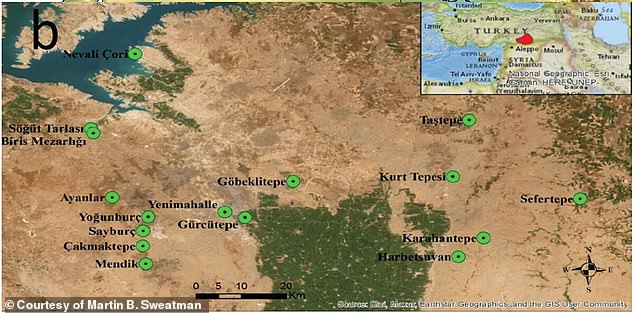
Researchers discovered the pillar at the archaeological site of Göbekli Tepe in southern Turkey
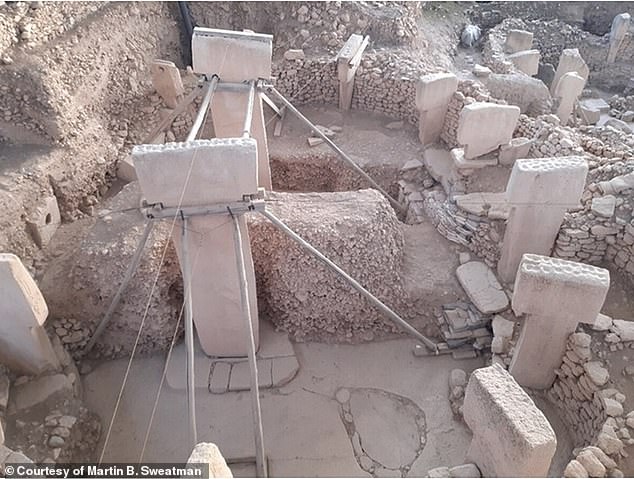
The researchers discovered the solar calendar on pillars at a 12,000-year-old archaeological site (photo)
According to the studypublished in Time and Mind, the pillar features a disk representing the sun and the scorpion symbolizes the Greek constellation Scorpio.
The team also discovered a large bird leaning toward a writhing snake, which could represent the autumnal constellation Ophiuchus.
The discovery suggests that humans recorded data using precession, the wobble of the Earth’s axis that affects the movement of constellations in the sky.
It was long believed that the ancient Greeks were the first to use this method in 150 BC.
But the most important discovery was that the ancient inhabitants commemorated a catastrophic comet impact.
The team has been working on the site for a long time and has decided to start in 2021 study that the comet struck about 13,000 years ago, based on the high concentrations of platinum and nanodiamonds created during high-energy explosions of comets.
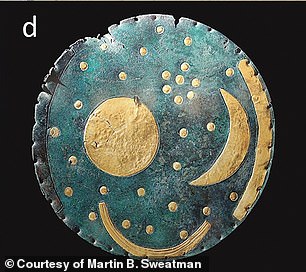
Pictured: The Nebra sky disk found in Germany, which contains symbols for the sun, moon, Pleiades and a possible comet
This celestial event occurs when a comet’s orbit crosses Earth, causing objects to collide with each other, which can have major and dramatic consequences.
Researchers compared the column carvings to symbols on other ancient artifacts and confirmed that the latest discovery did indeed depict a solar calendar and the pivotal comet impact.
Among these was a sky disk artifact from the second millennium BC in Germany, showing the sun, moon, and the Pleiades (a star cluster in the constellation Taurus). This cluster is thought to mark the summer and winter solstices.
However, the last feature was at the bottom of the disk, which showed a long, curved shape with parallel lines, which could represent a comet, the study said.
Researchers reported that the latest engravings showed similar comet fragment symbols originating from the constellations Aquarius and Pisces.
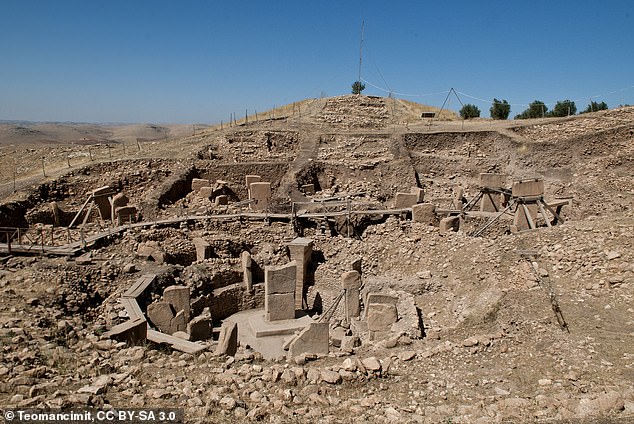
The Gobekli Tepe site is known as the oldest city ever found. The city was built between 9,600 and 8,200 BC, which is more than 6,000 years older than Stonehenge.
The comet fragments struck Earth nearly 13,000 years ago—around 10,850 B.C.—and caused the extinction of several large animal species. It was the largest comet impact since the event that led to the extinction of the dinosaurs 66 million years ago.
It is thought that the extinction of animals led to changes in agriculture, which led to the development of more complex societies. These societies then gave rise to modern civilization in the Fertile Crescent, which consists of the countries we now know as Egypt, Iraq, and Lebanon.
The team also discovered a second pillar representing the Taurid meteor stream, which lasted 27 days and could be the source of the comet fragments.
